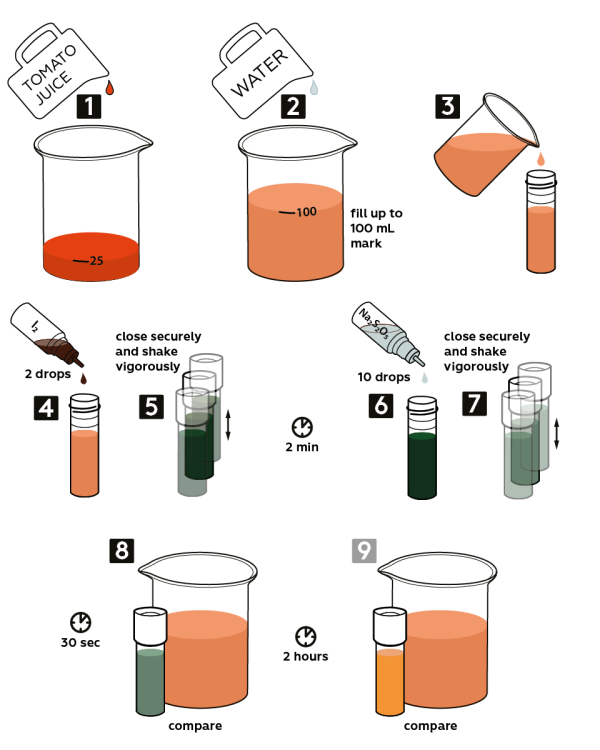Tomato juice
Lycopene oxidation turns tomato juice green

Safety
- Put on protective gloves and eyewear.
- Conduct the experiment on the tray.
- Do not allow chemicals to come into contact with the eyes or mouth.
- Keep young children, animals and those not wearing eye protection away from the experimental area.
- Store this experimental set out of reach of children under 12 years of age.
- Clean all equipment after use.
- Make sure that all containers are fully closed and properly stored after use.
- Ensure that all empty containers are disposed of properly.
- Do not use any equipment which has not been supplied with the set or recommended in the instructions for use.
- Do not replace foodstuffs in original container. Dispose of immediately.
- In case of eye contact: Wash out eye with plenty of water, holding eye open if necessary. Seek immediate medical advice.
- If swallowed: Wash out mouth with water, drink some fresh water. Do not induce vomiting. Seek immediate medical advice.
- In case of inhalation: Remove person to fresh air.
- In case of skin contact and burns: Wash affected area with plenty of water for at least 10 minutes.
- In case of doubt, seek medical advice without delay. Take the chemical and its container with you.
- In case of injury always seek medical advice.
- The incorrect use of chemicals can cause injury and damage to health. Only carry out those experiments which are listed in the instructions.
- This experimental set is for use only by children over 12 years.
- Because children’s abilities vary so much, even within age groups, supervising adults should exercise discretion as to which experiments are suitable and safe for them. The instructions should enable supervisors to assess any experiment to establish its suitability for a particular child.
- The supervising adult should discuss the warnings and safety information with the child or children before commencing the experiments. Particular attention should be paid to the safe handling of acids, alkalis and flammable liquids.
- The area surrounding the experiment should be kept clear of any obstructions and away from the storage of food. It should be well lit and ventilated and close to a water supply. A solid table with a heat resistant top should be provided
- Substances in non-reclosable packaging should be used up (completely) during the course of one experiment, i.e. after opening the package.
FAQ and troubleshooting
Juice didn’t turn greyish-green when I added iodine solution (step 4). What to do?
The amount of iodine I2, which should be added into the juice, may depend on kind of tomatoes it was made from. Lycopene (pigment coloring tomatoes red) content may vary, and it seems like your tomato juice contains a lot of lycopene. Try adding 2 more drops of iodine solution.
Step-by-step instructions
-
Take a beaker and pour in tomato juice up to 25 mL mark.
-
Add there water up to 100 mL mark.
-
Fill the vial 2/3 full with diluted tomato juice.
-
Add 2 drops of 0.05M iodine solution into the vial.
-
Close the vial securely and shake. Wait 2 min.
-
Now, add 10 drops of 0.5M sodium pyrosulfite Na2S2O5 solution into the vial.
-
Again, close the vial securely and shake. Wait 30 sec.
-
Compare color of solutions in the vial and in the beaker.
-
In 2 hours, solution in the vial will restore its color.

Disposal
Dispose of solid waste together with household garbage. Pour solutions down the sink. Wash with an excess of water.